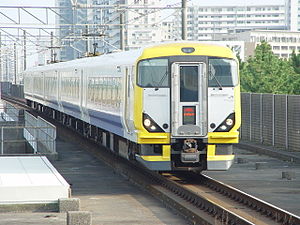Sazanami (train)
Appearance
 A E257-500 series EMU on a Sazanami service in October 2006 | |
| Overview | |
|---|---|
| Service type | Limited express |
| Status | Operational |
| Locale | Chiba Prefecture |
| First service | 15 July 1972 |
| Current operator(s) | JR East |
| Former operator(s) | JNR |
| Route | |
| Termini | Tokyo Tateyama |
| Distance travelled | 128.9 km (80.1 mi) |
| Service frequency | 4 return services daily |
| Line(s) used | Keiyo Line, Uchibo Line, Sobu Line |
| On-board services | |
| Catering facilities | Trolley service |
| Technical | |
| Rolling stock | E257-500 series EMUs |
| Track gauge | 1,067 mm (3 ft 6 in) |
| Electrification | 1,500 V DC overhead |
| Operating speed | 120 km/h (75 mph) |
The Sazanami (さざなみ) is a limited express train service in Japan operated by East Japan Railway Company (JR East). It runs between Tokyo and Tateyama via the Keiyo Line and Uchibō Line.[1]
Seasonal Shinjuku Sazanami services operate at certain weekends between Shinjuku and Tateyama.
Principal stations served Tokyo - Soga - Goi - Kisarazu - Kimitsu - Tateyama
Rolling stock
- E257-500 series 5-car EMUs
-
A E257-500 series EMU on a Shinjuku Sazanami service in May 2010
Former rolling stock
- 255 series 9-car EMUs[2]
- 183/189 series 9-car EMUs[2]
-
A 189 series EMU on a Shinjuku Sazanami service in February 2007
-
A 255 series EMU on a Sazanami service in March 2008
History
- 15 July 1972 - Sazanami service starts coinciding with opening of the underground Sōbu Line platforms at Tokyo Station.
- 16 March 1991 - Sazanami service are rerouted via the Keiyo Line from Tokyo.
- 2 July 1993 - 255 series EMUs are introduced on View Sazanami services from Tokyo to Chikura.
- 16 October 2004 - E257-500 series EMUs are introduced.
- 10 December 2005 - The View Sazanami name is discontinued, and all services are made entirely no-smoking.[3]
The opening of the Tokyo Bay Aqua-Line road across the Tokyo Bay in 1997 saw increased competition from long-distance bus services offering cheaper fares, resulting in decreasing ridership figures on the Sazanami services.[4] From the start of the 15 March 2014 timetable revision, the number of services was reduced to six return workings daily.[4]
See also
References
- ^ JR新幹線&特急列車ファイル [JR Shinkansen & Limited Express Train File]. Japan: Kotsu Shimbun. 2008. p. 66. ISBN 978-4-330-00608-6.
- ^ a b 日本と世界の鉄道カタログ'97~'98 [Japan and World Railway Catalogue 1997-1998] (in Japanese). Japan: Seibido Publishing. 17 August 1997. pp. 147, 157. ISBN 4-415-09254-3.
- ^ 2005年12月ダイヤ改正について [Details of December 2005 Timetable Revision] (PDF) (Press release) (in Japanese). East Japan Railway Company. 30 September 2005. Retrieved 25 June 2012.
{{cite press release}}: Cite has empty unknown parameter:|1=(help) - ^ a b 房総特急 引き潮 高速道充実で利用者減少 [Boso limited expresses ebbing: Passenger numbers falling due to improved expressway network]. Tokyo Shimbun Web (in Japanese). Japan: The Chunichi Shimbun. 25 March 2015. Archived from the original on 26 March 2014. Retrieved 26 March 2014.
External links
Wikimedia Commons has media related to Sazanami (train).
- JR East 255 series Shiosai/Wakashio/Sazanami (in Japanese)
- JR East E257 series Wakashio/Sazanami/Shiosai/Ayame (in Japanese)



